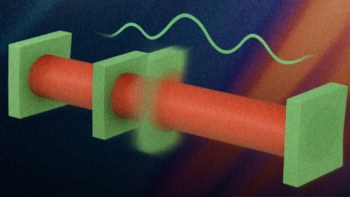“Dragging” ultracold ions across an optical lattice has provided important insights into friction. By tweaking the distance between the ions, Alexei Bylinskii, Dorian Gangloff and Vladan Vuletić of the Massachusetts Institute of Technology in the US were able to reduce the friction between the two by a factor of 100. Their work could provide important insights into “superlubricity” and further the development of tiny mechanical devices.
Friction often occurs as a “stick–slip” process whereby two objects slide over each other with a jerking motion. While this suggests that the objects are alternatively grabbing and then releasing each other, the exact physical process is not well understood at the atomic scale. Even more puzzling is the phenomenon of superlubricity, in which some objects can slide over each other with zero friction.
Stuck in the gaps
One possible explanation for these processes is that friction is greatest when the spacing between atoms at the surface of one object is the same or commensurate with the spacing at the surface of the other object. In this case, all of the atoms on one surface will become stuck in the gaps between atoms in the other surface. When a sliding force is applied, it must be large enough to wrench all of these atoms out of the gaps before they slip into the next gap and become stuck again. If the gaps and atoms are incommensurate, fewer atoms will get stuck and friction will be weaker. If the mismatch is very large, then superlubricity could occur. This is the essence of the Frenkel–Kontorova (FK) model of friction, which was first suggested more than 75 years ago.
To understand how this transition from slip–stick to superlubricity occurs, Vuletić’s team looked at what happens when a line of equally spaced ions slides across a 1D optical lattice – which is essentially a standing wave of light with peaks and troughs of intensity. The experiment involves cooling ytterbium ions to a temperature of near absolute zero (48 μK), and holding as many as six ions in a line using electric fields. The mutual electrical repulsion of the ions causes them to separate with a spacing of 6 μm. The wavelength of the optical lattice is about 185 nm.
Drag and drop
The line of ions is “dragged” across the lattice by applying an electric field in that direction. When an ion “slips” from one trough to the next, it emits fluorescent light, which is detected by a microscope. When the ions and the lattice are commensurate, the team measures a relatively large friction force. When the experiment is repeated several times using ion separations that are increasingly incommensurate, friction falls by a factor of 100.
By observing the light emitted by the ions as they move, the team showed that all of the ions in a commensurate line were sticking simultaneously after a slip. However, in a mismatched line only some of the ions appeared to be sticking after a slip – behaviour that is predicted by the FK model.
“What we can do is adjust at will the distance between the ions to either be matched to the optical lattice for maximum friction, or mismatched for no friction,” Vuletić says. He describes the commensurate stick–slip process as being like an earthquake: “There’s force building up, and then there’s suddenly a catastrophic release of energy.” In contrast, incommensurate sliding is much smoother, with some ions sticking in troughs and others ending up at peaks where they are free to move. An animation of both motions is shown in the video above.
Temperature dependent
The researchers also found evidence that temperature had a very significant effect on the friction – even at 48 μK. This is because their observations are best described by a model that includes the thermal motion of the ions.
Friction is important for those trying to build extremely small machines, because frictional processes that have little effect on large devices can completely gum up a nanoscale device. Therefore, the insights from this latest research could lead to the development of materials with tailored frictional properties. The work could also provide important insights into the operation of “molecular motors” in living organisms, which make clever use of friction.
The research is reported in Science.



